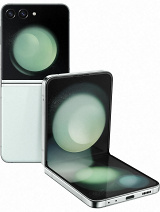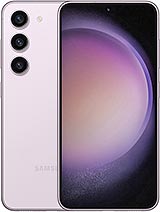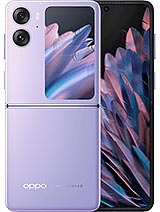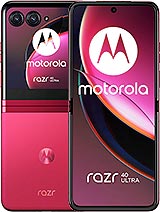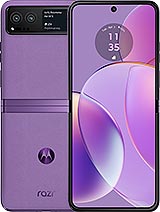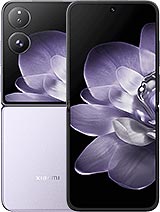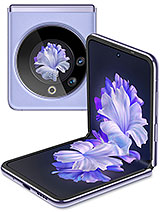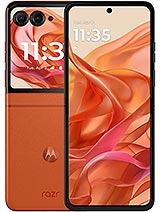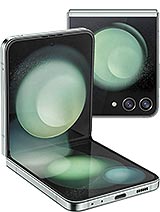Samsung Galaxy Z Flip5 review

New 3.4-inch cover display, same-ish foldable 6.7-inch one inside
A cosmetic, as well as a functional upgrade, the Galaxy Z Flip5's larger outer screen is one of the key selling points of the new model when compared to the 2022 generation. It covers a significant portion of the top half of the Flip, notched slightly in one corner to accommodate the cameras. On the inside, meanwhile, changes remain minimal (but, as it turned out, measurable).
 Galaxy Z Flip5 (left) next to Z Flip5 - 3.4 vs 1.9 inches
Galaxy Z Flip5 (left) next to Z Flip5 - 3.4 vs 1.9 inches
The cover display, which Samsung insists on calling Flex Window, has a 3.4-inch diagonal resolution of 720x748px, though obviously, some of those pixels have been eaten by the camera notch. The 306ppi pixel density means it's not quite as sharp as the main one, but it's easily good enough.
Another area where it fails to match the internal panel is refresh rate - the cover display maxes out at 60Hz, which feels like too little in a world where the Razr 40 Ultra can go as high as 144Hz on its cover.
Where the outer screen does match the foldable panel is in maximum brightness. The cover has a dedicated ambient light sensor and will use the readings from it to auto-adjust its own brightness all the way up to 1092nits in our testing.

Which does bring us to the internal display. We measured 1101nits with the brightness control outsourced to the auto toggle - a nearly 200-nit upgrade over the Z Flip4's result. It still can't quite match the S23's 1200nits, but it's close enough. Samsung specifies a 1,750-nit value for 'peak' brightness on the Z Flip5, up from 1,200 on the previous model, though that's for use cases outside of our testing scenario.
With the auto toggle off, you can expect around 800nits in 'Extra brightness' mode (we got 789) or 500-ish if you'd like to limit your battery consumption and disable the Extra (we measured 481nits on our unit). These results are roughly the same as on the Z Flip4 and the S23.
Brightness results of the internal display came before its specs this time around because we wanted to cover the changes first, and there aren't any in the specsheet. It's still a Dynamic AMOLED 2X panel with a 120Hz maximum refresh rate that can ramp down to as low as 1Hz. Its diagonal remains at 6.7 inches, and its resolution is 2640x1080px in a tall 22:9 aspect ratio (pixel density is 425ppi). HDR10+ support is also part of the package.
Color accuracy
Display color handling on the Z Flip5 is the same as on most Galaxies. You get two modes - Vivid and Natural. In the default Vivid mode, you get livelier output and wide color gamut. Overall accuracy is very good, but there is a moderate blue shift in white and grays. Nudging the five-position temperature slider one notch towards warm fixes that. Natural mode, on the other hand, is tuned for sRGB content and is remarkably accurate in its rendition, though it may look a little dull in comparison to Vivid (expectedly).
HDR and streaming
The Galaxy Z Flip5 supports HDR10+, and we got HDR streams from both YouTube and Netflix. The Widevine L1 certification means you get FullHD playback in apps that stream DRM-protected content.
Refresh rate
As is the case on most Samsungs, the Motion smoothness menu on the Z Flip5 gives you two options for refresh rate - Adaptive and Standard. Also customarily, the names are somewhat misleading, because there will be adaptive behavior in both modes, and Standard won't be 60Hz all the time. Effectively, you can treat the modes as different ceilings - up to 120Hz and up to 60Hz - whichever one you prefer.
Within those boundaries, we observed very predictable and logical adaptive behavior. If you're touching the phone, you get to the ceiling; if not - you get 24Hz. Unless there's moving content on the screen, in which case the phone will maintain whatever refresh rate is most appropriate - up to 60Hz for browsers or to match a video's frame rate in video playback (24, 30, 48, 60 fps/Hz are supported).

There don't appear to be brightness thresholds for dropping the refresh rate as we've seen on some earlier adaptive implementations - the Z Flip5 will go to 24Hz even with minimum brightness set on the slider.
We didn't observe values below 24Hz, but that could very well be another case of our observing the phenomenon actually altering the phenomenon. Then there's the matter of frame rate vs. refresh rate and the phone could be rendering at a lower rate than the screen is refreshing at. Samsung specs say it can go down to 1Hz, and there is probably a scenario where it does actually achieve that - it's just that we can't name it.
Realistically, it's hard to ask anything more out of this panel from the standpoint of its actual display qualities - it's the physical side of things with the groove in the middle that we're not so sure about.
As for the cover screen, we saw no reading on it other than 60Hz. That's in line with Samsung's official specs, which only state a single value of 60Hz, whereas they quote a range for the main display (1-120Hz).
Samsung Galaxy Z Flip5 battery life
The Galaxy Z Flip5 is powered by the same 3,700mAh battery that the old model had. The Razr 40 Ultra is about there as well (3,800mAh), while the China-only clamshells opt for larger capacities - the Oppo Find N3 Flip stands at 4,300mAh, and the vivo X Flip adds another 100mAh on top of that.
In our Active Use test, the Galaxy Z Flip5 is noticeably behind the other clamshell we have data on, the Oppo Find N3 Flip. Compact conventional phones like the Galaxy S23 and the Zenfone 10 are also longer-lasting.
Expand to reveal our legacy battery test (Endurance rating). How we test now.
In our testing, the Galaxy Z Flip5 was good for a little over 15 hours of video playback and 12 hours of Wi-Fi web browsing - not amazing, not half bad either. The nearly 28 hours on a voice call are about the norm for a clamshell. In the end, the overall Endurance rating of the Galaxy Z Flip5 worked out to 87h.
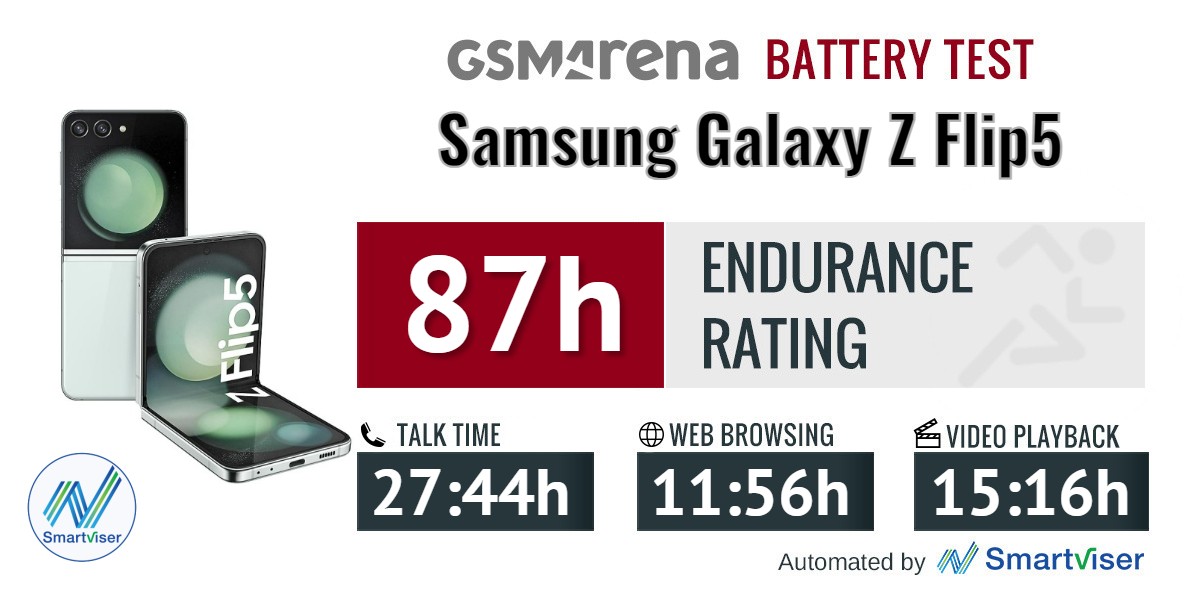
Our battery tests were automated thanks to SmartViser, using its viSerDevice app. The endurance rating denotes how long the battery charge will last you if you use the device for an hour of telephony, web browsing, and video playback daily. More details can be found here.
While testing the Z Flip5, we figured we'd retest the Z Flip4 as well. This produced lower results for the 2022 clamshell than what we got initially, which can be explained by many factors, but mostly the different software between the two tests. In any case, we've updated the Galaxy Z Flip4's results to reflect its current state as of writing the Galaxy Z Flip5's review, and it will be those numbers that go in future comparisons.
With that in mind, the Galaxy Z Flip5 is a noticeable step up in battery life compared to the Z Flip4. It's essentially a tie between the latest Galaxy and the Razr 40 Ultra, while both the Oppo and the vivo (especially) offer better longevity. There's also the Galaxy S23 that will get you a few extra minutes on a charge, if you'd prefer to go non-foldable.
Video test carried out in 60Hz refresh rate mode. Web browsing test done at the display's highest refresh rate whenever possible. Refer to the respective reviews for specifics. To adjust the endurance rating formula to match your own usage - check out our all-time battery test results chart.
Charging speed
The barebones retail package means you'll need to supply your own charger to keep the Z Flip5 running. A good USB PowerDelivery unit with support for PPS (Programmable Power Supply) that supports 25W or more should do a fine job - the Z Flip itself is rated for 25W.

We tested using the company's own 'standard' 25W adapter and didn't really get any surprises. The Flip 5 charges as fast as the Z Flip4 in the first 30min but for some reason, the charging to 100% is much faster on the Z Flip4.
Update, 22 Aug 2024: We've retested the charging speed for Galaxy Z Flip4, Z Flip5 and Z Flip6 and we've updated the charging speed results in the chart below.
The Galaxy Z Flip5 can be charged wirelessly and it can charge other devices too. The certification listing at the WPC states that the phone complies with the Basic Power Profile for power transfer up to 4.4W. As is normally the case with Galaxies, that rating only tells half the story and using compatible pads will actually get you up to 15W of charging power - what Samsung calls Fast Wireless Charging 2.0.
Speaker test
The Galaxy Z Flip5's speaker system doesn't stray from the norm - one bottom speaker and another one at the top, which also doubles as earpiece. In portrait orientation, the top one gets the left channel, while in landscape, the phone will assign the channels dynamically to correspond to the handset's orientation in space.


Bottom speaker • Earpiece/top speaker
The Z Flip5 earned a 'Good' rating for loudness in our test, on par with the previous generation and the S23 alike. The Razr 40 Ultra, meanwhile, is louder, numerically, and sits a notch up in terms of rating.
When it comes to sound quality, the new Flip is about the same as the old Flip. We're getting clean vocals and well-defined treble, with a decent low-end response too. The S23 is similar in most respects but offers a little bit more bass. The Motorola doesn't have quite as good of a presence in the highs as the Galaxies - we'd pick a Flip over a Razr for speakers quality.
Use the Playback controls to listen to the phone sample recordings (best use headphones). We measure the average loudness of the speakers in LUFS. A lower absolute value means a louder sound. A look at the frequency response chart will tell you how far off the ideal "0db" flat line is the reproduction of the bass, treble, and mid frequencies. You can add more phones to compare how they differ. The scores and ratings are not comparable with our older loudspeaker test. Learn more about how we test here.
Reader comments
- Sarkirssian
- 26 Oct 2024
- 8nN
You need to take care of things. Mine still like new after more than a year.
- JUSTIN
- 29 Sep 2024
- S1c
Don't buy the phone, mine in 1 year screen protector already has air under it and need to be changed...also the camera is a total disaster. No good pictures..Go for the S25 or Apple.
- E-San
- 10 Sep 2024
- 58@
bought my flip 5 in May 2024, it's been great since... very nice performance even for gaming, and I love the style, the cam could be better, and battery life, but the phone is compact, it was expected. The complaint is about the screen protector...

